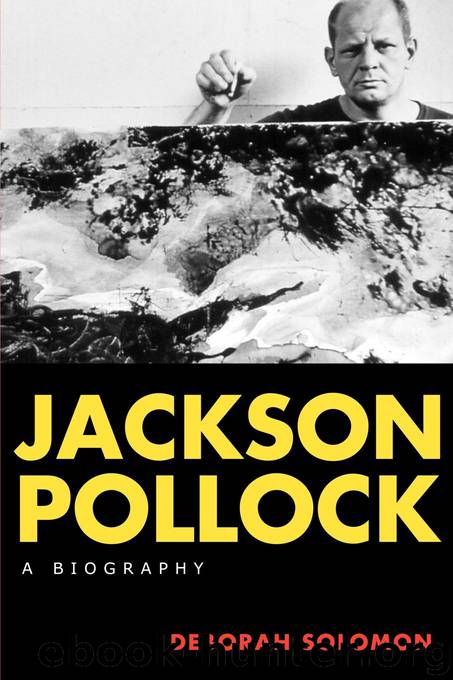Jackson Pollock by Deborah Solomon

Author:Deborah Solomon
Language: eng
Format: epub
Publisher: Rowman & Littlefield
Published: 2001-06-10T16:00:00+00:00
In the year that had passed since Pollock had completed his mural hardly anyone had seen it, for the simple reason that it was hanging in his patron’s apartment. But Peggy Guggenheim was eager to show it off to the public, convinced that it represented the high point of Pollock’s career. On March 19, 1945, she held a reception at her apartment to coincide with the opening of Pollock’s second show. More than a hundred guests showed up, and their reactions to the mural were predictably varied.
Among the viewers was Clement Greenberg, of The Nation. He admired the mural enormously. “People said it just went on and on like glorified wallpaper,” he later said. “I thought it was great.” Seeing the mural marked a decisive moment in Greenberg’s intellectual life. It was then that he realized that Pollock was something more than just a talented painter; he was nothing less than the one American artist who could give expression to the complex innovations of European painting while still managing to look quintessentially American. “I wanted to see somebody come along,” Greenberg explained, “who could match the French so we could stop being minor painters over here.” In Pollock he found him, an artist who had not only assimilated Picasso but had gone on to challenge him. Pollock, he believed, was the legitimate heir to the modernist tradition in art.
The two men became close friends. With Pollock’s encouragement, Greenberg began stopping by 46 East Eighth Street on a regular basis to look around his studio and see how his work was progressing. A painter himself, Greenberg had grown up in the Bronx, the son of Polish immigrants, and had started drawing at the age of four. “I copied everything,” he once said. “I got pretty good at working from nature.” After studying literature at Syracuse University, he started his writing career as a literary critic but turned to art criticism in the forties, writing reviews for The Nation and longer, more theoretical pieces for Partisan Review. He had great confidence in his own opinions, which gave him an air of authority in spite of his ordinary appearance and polite, sometimes clumsy manner. On his visits to Pollock’s studio Greenberg was always terse in his appraisals. “Mmm,” he might say, admiring a painting, “that’s good.” He provided Pollock with essential support at a time when few people realized how good Pollock was.
Reviewing Pollock’s recent show, Greenberg was ardent in his praise. “Pollock’s second one-man show at Art of This Century establishes him, in my opinion, as the strongest painter of his generation and perhaps the greatest to appear since Miró. . . . There has been a certain amount of self-deception in School of Paris art since the exit of cubism. In Pollock there is absolutely none, and he is not afraid to look ugly—all profoundly original art looks ugly at first.”
But no other critics seemed to like the show—not the few who reviewed it. Maude Riley, writing in Art Digest, confessed straightforwardly: “I really don’t get what it’s all about.
Download
This site does not store any files on its server. We only index and link to content provided by other sites. Please contact the content providers to delete copyright contents if any and email us, we'll remove relevant links or contents immediately.
The Secret History by Donna Tartt(16738)
Red Sparrow by Jason Matthews(4727)
Harry Potter 02 & The Chamber Of Secrets (Illustrated) by J.K. Rowling(3306)
In a Sunburned Country by Bill Bryson(2971)
Figure Drawing for Artists by Steve Huston(2824)
The Daily Stoic by Holiday Ryan & Hanselman Stephen(2731)
Drawing Cutting Edge Anatomy by Christopher Hart(2708)
The Roots of Romanticism (Second Edition) by Berlin Isaiah Hardy Henry Gray John(2582)
Japanese Design by Patricia J. Graham(2582)
Make Comics Like the Pros by Greg Pak(2448)
Stacked Decks by The Rotenberg Collection(2303)
Harry Potter and the Deathly Hallows (7) by J.K. Rowling(2249)
Harry Potter and the Prisoner of Azkaban (Book 3) by J. K. Rowling(2169)
On Photography by Susan Sontag(2157)
Draw-A-Saurus by James Silvani(2124)
Tattoo Art by Doralba Picerno(2101)
Foreign Devils on the Silk Road: The Search for the Lost Treasures of Central Asia by Peter Hopkirk(2074)
Churchill by Paul Johnson(2032)
The Traveler's Gift by Andy Andrews(2031)
